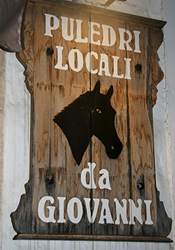This story appeared in Venturing in Puglia, a Land Between Two Seas (Travelers’ Tales, 2008). By Laurie McAndish King
The instructions were unnerving: Boil olive oil in a hot pan, lay the horsemeat in flat, and turn it when it starts to rise. I tried hard not to visualize horseflesh rearing up out of a pan of boiling oil.
We were in search of the “Puglian delicacy” I had read about in a guidebook and was determined not to miss. My plan was to find a restaurant that served horsemeat, convince one of my more adventuresome traveling companions to order it, and then to beg the smallest bite, just a tiny taste—after all, it was a regional specialty. But things did not work out according to my plan.
I first asked at Casa Nova in Alberobello. It was a white-tablecloth restaurant with a large menu, and seemed a likely source. But I was met with a puzzled expression. No, they did not serve carne de cavalle.
Perhaps the waiter did not understand my broken Italian. “Horse, cavalle?” I repeated, pantomiming a gallop. I felt foolish pantomiming in a nice restaurant, but I was halfway around the world and really wanted to try horsemeat.
“No. No cavalle.”
No matter; we still had more than a week to go. I would find it at the next restaurant. I persisted at Osteria degli Angeli in Lecci, at Ristorante Orsa Maggiore in Castro Marina and at La Sommita in Ostuni. Surely these fine Puglian establishments served the local specialty. But not a single one offered it. I tried requesting carne equine, thinking perhaps I had used the wrong word, but no matter how I asked, horsemeat was simply not on the menu. I enlisted the assistance of my travel companions: would they help me find a menu with horsemeat?
“Horsemeat?” MJ asked incredulously. “You want to eat horsemeat? Why?”
“It’s a specialty of the region,” I explained.
“I thought you were a vegetarian. How could you eat Mr. Ed?”
“I’m not completely. And I just want to try him. I mean it.”
They promised to help look. Days passed, but no one found cavalle. (If I had not been looking myself, I would have doubted their sincerity.) Taking a seat one evening at La Cantina, I had nearly given up the search, when Connie and Linda spotted Involtino al sugo di vitello o puledro on the menu and alerted me from across the room.
“Rolls of veal or horse and tomatoes,” the translation read.
There it was.
In that moment, when I expected to feel delight, a seed of doubt arose. I was not certain whether I could actually eat an equine. I had never owned a horse; my personal experience of them was not unlike my experience of cows, visible chiefly in rural fields, and from a distance. I eat steak occasionally, but I began to worry that horses might somehow be different. Could I actually consume a Seabiscuit steak? A Black Beauty roast? Filet o’ Flicka? My companions were watching, waiting-probably thinking I would not go through with it.
I ordered the involtino.
The waiter raised his eyebrow in what I took to be a disapproving look. Although horsemeat was listed on the menu, he informed me, La Cantina was not serving it tonight.
I began to wonder whether the dish really existed. Perhaps it was the Puglian equivalent of an urban legend, making for colorful copy in the guidebooks, teasing tourists, even appearing on the occasional menu, but never materializing in an actual meal. And perhaps that was just as well.
But Annelize assured me that horsemeat is indeed eaten in Europe: “It is common in France, where culinary appreciation surpasses sentimentality,” she explained. This perspective momentarily renewed my resolve, as I am not accustomed to being accused of sentimentality. “I ate it a lot as a student in Holland. It is very tender in comparison to the average beef,” Annelize continued. “The muscle structure is somewhat coarser, the taste a little sweeter. I imagine it is comparable to human flesh; that is what cannibals report.”
Cannibals? I did not like the direction this was heading!
The expression on my face must have matched my flagging enthusiasm, because later that evening Chrysa took it upon herself to assist in the quest. Since I had had no success at restaurants, we switched to butcher shops. If they served the restaurant business, they would be able to tell us which restaurants to try. We located a butcher shop that sold beef, veal, goat, sheep, pork, chicken … everything, it seemed, except horsemeat.
“Si vendono il carne de cavalle, do you sell horsemeat?”
“Cavalle? No.”
Did they know where we might find it?
“No.”
 Chrysa persisted, searching up and down Alberobello’s steep, narrow streets. Three hundred meters down the main road, Largo Martellotta, she saw the sign: Macelleria Carne Equina. (Surely the locals all knew it.) A second sign outside the shop featured a large horse’s head…
Chrysa persisted, searching up and down Alberobello’s steep, narrow streets. Three hundred meters down the main road, Largo Martellotta, she saw the sign: Macelleria Carne Equina. (Surely the locals all knew it.) A second sign outside the shop featured a large horse’s head…
Read the rest of this story in Travelers’ Tales Venturing in Puglia, Land Between Two Seas:









